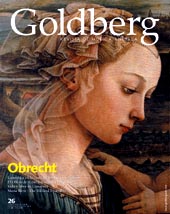|
El Cancionero de la Colombina
(1451-1506) |
|
| |
|
Description
Artistes / Performers
Hespèrion XX, dir. Jordi Savall
Lieu d'enregistrement / Recording site:
Collégiale romane du Château de Cardona (Catalogne/Catalunya)
Dates d'enregistrement: juin/juillet 1991
Recording dates: 06-07/1991 Durée totale / Total time: 72'20
|
|
|
Appréciation (s) /
Review(s)
|
|
Gramophone-
(07/1992)
|

|
Subscription
Abonnement |
|
Reviewer: David
Fallows
Abridged text:
"The
Colombina disc seems to hit the mark far more often, partly because
there are more pieces of substance and the musicians show no
inclination to apologize for them. Some of the finest songs here are
performed instrumentally, but without fuss: they simply play the
music through, with its appropriate repeats and with a minimum of
embellishment. In doing so, the musicians bring out wonderful
qualities in these glorious songs. (Incidentally Nos. 7 and 15 are
exchanged here: it may not matter much except that Urrede, the
composer of No. 7, is one of the finest song composers of the age,
whereas Triana, who wrote No. 15, just occasionally produced an
impressive piece.) Even so, the truly memorable moments are in the
works that are actually sung: the Cornago/Ockeghem Que's mi vida,
Urrede's Nunca fue pena mayor and Cornago's Donde estas (here
wrongly given as by Urrede)."
|
|
Diapason- # 380
(03-1992)
|
|
Appréciation

Evaluation |
Abonnement
Subscription |
Analyste: Roger
Tellart
Texte abrégé:
"... Irremplaçable, avons-nous écrit à
propos du travail de Savall se penchant sur le passé musical des *Espagnes*
(comme on disait alors). C'est qu'avec son épouse Montserrat
Figueras, indispensable, elle aussi, dès qu'il s'agit de rendre vie
à *l'hispanité*, il regarde de l'intérieur ces musiques des racines
et de la mémoire, riche d'une expérience confortée par un prodigieux
parcours d'instrumentiste et d'homme de terrain. Inutile d'ajouter
que tous le suivent au doigt et à l'oeil, tant dans l'églogue ou la
plainte (le Dime, triste coraçon, à quatre voix
masculines, de Francisco de la Torre, lourd d'un sublime *mal à
l'âme*) que dans les intermèdes de détente où le *concert* à l'ancienne
s'en donne à coeur joie - enluminé comme il se doit des vives ou
sombres couleurs des cornets, saqueboutes et bassons d'époque. Il
règne ici un air de liberté et de savoir-faire, marié à un don du
*dire* et de la respiration (vocale comme instrumentale) qu'il
serait vain de chercher chez les autres. Bref, encore un album
incontournable pour tout amoureux des hautes époques et où l'art de
la *bande à Savall* est une fois de plus au sommet, qui s'abandonne
au plus précieux des dolorismes ou qui s'ouvre au mystère de
l'instant (fabuleux Pues con sobra de tristura de Enrique)
selon les humeurs des pièces choisies". |
Reviewer: Roger
Tellart
Abbreviated text in a free translation:
”… Incomparable, as we have often said about Savall’s work devoted
to the musical past of the Iberian peninsula. Together with his
wife, Montserrat Figueras, also indispensable when it comes to
revealing this Hispanic character, Savall looks from within at these
musics, so intimately linked to the roots and memories… Needless to
say that all his musicians follow him religiously, whether it be in
the plaintive songs (such as the Dime, triste coraçon for
three male voices of Francisco de la Torre…) or in the interludes
when the concert ‘à l’ancienne’ gives all it has, enlightened
as one would expect by the brilliant or the sombre colors of the
cornets, sackbuts and period bassoons.”
“In a word,
another reference album for any lover of early music, where the art
of Savall’s
musicians is again at the top of its capabilities…”. |
|

# 26
(02/2004)
|
 |
Appréciation

Evaluation
|
Abonnement
Subscription |
Analyste: Michael
Noone
Extrait:
"L’une
des grandes vertus de cet enregistrement, et dont Jordi Savall a
fait la marque distinctive de son ensemble Hespèrion XX, est le
souci de transmettre à l’auditeur la valeur intrinsèque de chaque
pièce sans jamais perdre la perspective d’ensemble, à travers la
variété et le divertissement; pour ce faire, il prend en compte le
sens du texte, l’expressivité et la couleur des voix choisies, les
mélanges d’instruments apportant de nouveaux effets de timbre, la
façon de souligner la beauté d’une mélodie ou la séduction
"
| |
![]()
![]()